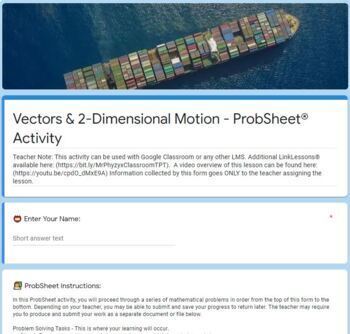Vectors & Two-Dimensional Motion ProbSheet® - Online Distance Blending Activity
- Google Forms™
- Internet Activities
- Webquests

Also included in
- General Activity Sequence in MOST LinkLessons:Introduction, objectives, and instructions. (2 min)Instructional Activities. (30 min) - meme, anchor phenomena, video, diagramsProduction Activities (30 min) - student-made graphs, simulations, digital concept maps, cartoons, presentations.Reflective wriPrice $125.00Original Price $152.00Save $27.00
Description
Short Description: Students practice math problems solving 10 word-problems concerning velocity in Physics: vectors, distance, displacement, speed, velocity, acceleration, and vector addition calculations. Some instructional media is present, but students should have had previous instruction such as found here. Some of the problems are self-grading, but the teacher will likely have to review student entry and click the X or checkmark.
See the video overview of How A ProbSheet Works.
Goes great with this Vectors & Two Dimensional Motion LinkLesson.
(Please download my free samples to be sure you understand what you are purchasing. Try the Scientific Method video activity. Get all of the free things!)
Long Description: This product is ready to install in your Google Drive or Google Classroom as a self-contained Google Form activity where students have to solve 10 word-problems of varying difficulty covering the basic concept of vector addition. Some instructional media may be present, but students should have a working knowledge. The formulas needed to solve the problems are presented in the activity. The form allows for customization with regard to significant digits according to the teacher. Some alternative answers are included and can be removed to increase rigor. Some answers self-grade, but a quick teacher check is recommended. Option included for attachment of scratch work files. (Approximately 55 min, 11 digital pages)
Activity Sequence:
- Introduction, objectives, and instructions. (2 min)
- Limited text, image, and/or video presentations of the content. (5min)
- Completion of problem-solving activities. (45 min)
- Attachment of scratch work images. (2 min)
Skills and Concepts Touched Upon:
- Technology Use
- Google Suite
- Logical problem solving
- Math Word Problems
- Calculator Use
- Physics, Physical Science
- Velocity, acceleratoin, displacement
- Vectors, addition, components
- Distance, Displacement, Speed, Velocity, Acceleration
- Standard Scientific Units
- Brief mentions of right triangles, coordinate systems, number lines, horizontal and vertical motion.
Be sure to edit settings on the form before use, default settings allow students to go back and edit after seeing the answers. Customize the settings to your needs.
Can be used in conjunction with my Digital Interactive Notebook, or as a completely independent activity and my free importable Google Classroom Activity Quality Rubric.






